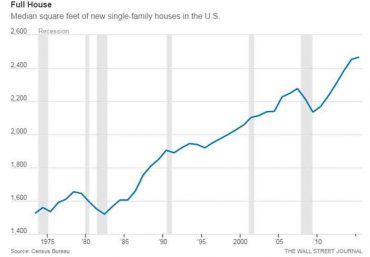
John Bleasby
“Tiny houses be damned! Super-size me!”
Canadian ContractorAverage new house sizes increase dramatically despite media pressure to downsize
It seems almost counter-intuitive that the average North American house size would grow despite more media attention encouraging the building of right-sized homes. However, statistics gathered from the U.S. Census Bureau indicate a desire to live a larger life. In fact, the

Average U.S. house size goes ever-higher!
average new American single-family home grew 57% from 1970 to 2014 to 2,657 square feet. Looking at the numbers even more closely one learns that in the past 15 years homes over 3,000 square feet now represent 33% of new builds nationally, versus only 17% in 1999.
One hand gives while the other takes away
What’s interesting is that this trend towards ever-larger homes full of electronic gadgets and appliances is cancelling out significant gains in per-square-foot energy gains offered through the advances in lighting, heating, and insulation over the same period. The U.S. Department of Efficiency and Renewable Energy reports that energy used in homes, as measure in Btu’s (British Thermal Units) per square foot dropped by 31% from 1970 to 2012. Deeper analysis finds that energy for heating dropped to 45.1% of total energy used, whereas energy used for electronics and appliances rose from 10.6% to 34.6%. It looks like leaving the computer on 24/7 and having smart appliances on stand-by has its costs!
Figures in Canada can be expected to be much the same. In fact, the strength of the Canadian home building and renovation industry has continued almost unabated over the past decade or more. In a desire to expand their personal living spaces, Canadians can choose between adding to or reconfiguring their existing home with a major renovation, or simply selling (at a profit in almost all areas) and buying bigger.

The neighborhood’s worst nightmare: a monster home next door!
The monster next door
Nicole Silver, Prudent Public Realtionist for TrustedPros, writes however that the trend toward ‘monster homes’ is complicating urban areas. “The desire to add massive home extensions or build gigantic houses is taking a toll on cities, and their residents. For most communities, monster homes are a monster sized problem. Some argue that monster homes are problematic because their size and style destroys the character of old neighbourhoods. They can also overshadow neighbouring homes, gentrify neighbourhoods, push residents out, force real estate prices to skyrocket, and drop neighbouring property value.” A monster home is generally regarded as a house over 5,000 square feet, although that might be regarded as understated in some uber-affluent neighborhoods.
The trend to tiny may not last, but energy efficiency is here to stay
In the meantime, the media feeding frenzy over tiny homes that includes numerous TV shows, specialty magazines, and promotional pitches from ardent environmental and lifestyle gurus continues, despite concerns over zoning, land use efficiencies and portability.
The reality is, however, that given the choice North Americans would like more space rather than less. That is not to say consumers are not concerned about energy efficiency. Studies discussed in U.S. publication Construction Dive suggest that not only are consumers willing to pay more for ‘green features’ but that sales of energy efficient homes with solar panels, high performance windows and green lighting will rise to between 26% to 33% of new single homes sold in the United States over the next few years. Given government incentives and policy directives expected in the near future aimed at reducing fossil fuel demand across the board in Canada, this country may experience similar levels of demands from consumers.
follow John on Twitter 
@john_bleasby

Leave a Reply